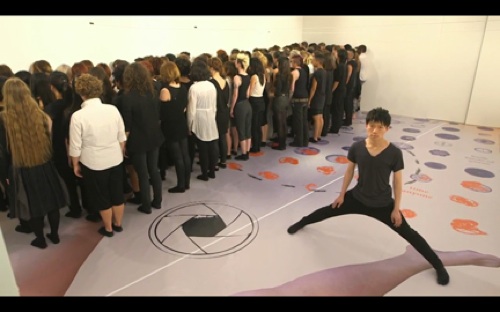
Emily Roysdon. “I Am a Helicopter, Camera, Queen,” May 31, 2012. Tate Live Performance Room, curated by Catherine Wood and Kathy Noble.
For my first post of 2013, I have interviewed artist and writer Emily Roysdon, whose interdisciplinary methodology takes the form of performance, photographic installation, print making, text, video, curating, and collaboration. We discuss her recent performance at the Tate Modern and her participation in MoMA’s first Annual Performance Symposium.
Marissa Perel: How did you conceive of the piece I am a helicopter, camera, queen? How did you think of performance as a critical tool in the context of the Tate?
Emily Roysdon: The Tate project had a very particular and precise framing. It was determined by the literal parameters of the room, which was very distinct and closed in with low ceilings and no windows. Then there was the broadcast element, which dictated that the performance was viewed live, online, on YouTube, which I thought of as another architecture. So, there were these two distinct spaces. I had to address the room that had been designated for performance in a museum, and also everyone on their computer waiting for the performance to go live. I liked the idea that it was a little bit of a risky series for the Tate, and for myself as an artist.
Emily Roysdon, “I am a helicopter, camera, queen,” May 31, 2012. Tate Live Performance Room, curated by Catherine Wood and Kathy Noble.
When the livestream opened I wanted the room to be full, for the viewers online to be looking at something that appeared as much as an audience as a performing body. Then there was the idea of ‘building the room’ or ‘making room’ for that form of spectatorship. I wanted the camera to be a character.
To explicitly address your question about performance as a critical tool: one way of thinking of it is as constituting an audience as opposed to performing a spectacle. We actually broke through to the adjacent room, the famously large Turbine Hall, and the piece took on a completely different form for that space.
MP: So, you wanted to push on all of the definitions and boundaries of the space? The definition of audience and participant, of the literal boundaries of the rooms and their meanings, and of performance occupying the museum?
ER: It’s pushing up against them but it’s also taking them seriously as parameters. I wasn’t going to make a performance for YouTube without considering the position and character of the camera.
MP: The structure implies a gaze and a history of that gaze that you’d want to work against, and an agency you want to have, and that you want the participants to have. It always seems like you are summoning a history in your work that is either present or absent in the spaces you are given, as if there is an absent body or collective body that the work implies. It’s very distinctive to me from modes of institutional critique where the artist is subject, and the viewer understands the implied trick that the artist is playing on the audience’s perception. There is something in your work that is distinctive from that mode, where the criticality is inviting, and the viewer can actually participate in that history, and can become aware of being part of a history they wouldn’t have known, had they not seen the work.
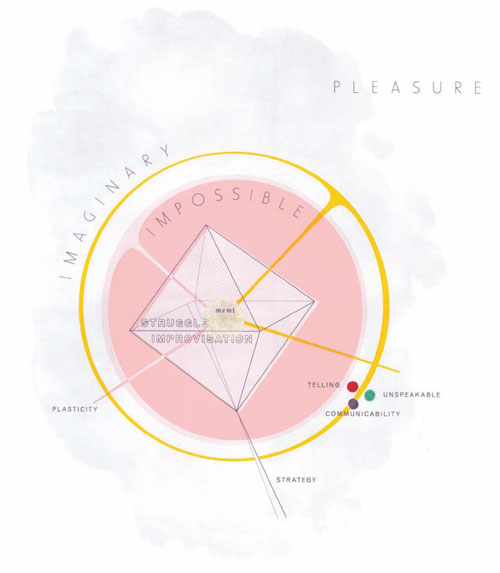
Emily Roysdon (designed in collaboration with Carl Williamson). “Ecstatic Resistance (schema),” 2009. Silkscreen and chine collé on paper. 34 ½ x 25 in. Printed by 10 Grand Press, Brooklyn, New York.
ER: What I do instead of focusing on the institutions is to focus on the lives of people that are there, to think of structures we can be alive inside of, and how we work together to build them. It’s about building what you want to see instead of critiquing what’s there. It’s a very different way of working. Obviously, I’ve been a student of activist histories and communities–Feminist, Queer, the AIDS crisis, and others.
MP: Is calling attention to what’s wrong an opposing standpoint from making what is possible? In thinking of your work, I see this in terms of shaping a possible world instead of pointing out what is not there. It’s a different form of rebellion, though it has, at its core, a form of revolt. How does revolt work with building a possible place?
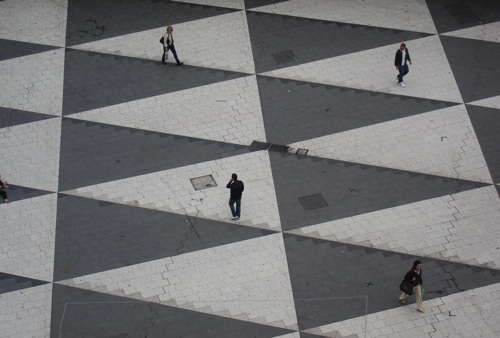
Emily Roysdon (a project with MPA). “Sense and Sense,” 2010. Digital chromogenic print. 19 × 17 in.
ER: Well, I am very concerned with my participation and complicity within these structures and institutions. I appreciate people who can take on institutions in a different way than I do. I appreciate people who are more adversarial. Most of my work is about language and taking on the vocabularies around these relationships and insisting on queer strategies, bodies, etc.
MP: It’s interesting to contend with this issue. I’m using institutional critique as a term but I see the definition as amorphous and changeable. I’m not invested in placing you in such a category, or to only propagate that value in performance. At the same time, I don’t see it as an object but as a set of relations that shift.
ER: This reminds me of the performance symposium at MoMA [in New York] that I was invited to speak at. Of course institutional critique was broached because we’re at MoMA and we’re discussing performance, and why in 2012 is it the first annual performance symposium? Where have they been for the past 50 years?
MP: Is it that performance was a threat to MoMA previously? And now there is something that is useful in it for the institution. I still have suspicions that something must be repressed that could threaten the institution.
The Annual Performance Symposium at MoMA: How Are We Performing Today? New Formats, Places, and Practices of Performance-Related Art, Nov 17-18 2012. Click at 1 minute and 40 seconds to hear Roysdon’s lecture.
ER: It’s one thing to think about what performance will do to an institution like that, but its another to think of the framing. MoMA’s workings are ancient. Their decision-making process, departments, and hierarchy is codified. To paraphrase Catherine Wood, who has been thinking through these questions for years now, when it comes to the idea of collecting performance or treating performance like fine art, it disrupts the tenants of the museum on a fundamental level. If you take it seriously, there is no other way than to see it as a disruption.
MP: It comes down to economic cycles and what works at a certain time. It’s looking a lot like the 1970s but now there are more codes and regulations without systemic support on the other end.
ER: There was a lot of talk about the experience economy at the panel. How we are constituting that economy and building it at the same time. But that’s not really what I’m interested in.
MP: Why does this need to become the priority now? Why is the art world the target? Can it be one place in a continuum of places? Why do performers need to concern themselves with the value of this institution because it is choosing to look this way now?
ER: It’s contentious. I think it’s troubling that the art world is the privileged site in this resurgence of performance practice, given that there is more experience, history, and care for performance and performers in other scenes and institutions. I mean, when MoMA calls, you pick up the phone. But I try not to let the site take over my imagination. I’m still invested in queer lives and histories.
MP: How do you see the place of the body in your work, either yours, an absent body, or historical body?
ER: When I first started making my work, it was more about the body, desire, etc. Now I say that I like to make work in the scale of my life and of people’s lives. I like to do things with what’s immediate. For instance, I don’t plan projects where I have to rent a crane and get a crew to hold a microphone. I just ask the person I’m working with to hold the camera, and then I hold the camera, and we’re just doing it. In that sense, the body becomes everything that’s possible. It’s both philosophical and practical. With regard to queer bodies, critics tend to want to target collaborators and subjects of my work and say, ‘That’s a transsexual.’ Yes, but that’s not the whole picture.
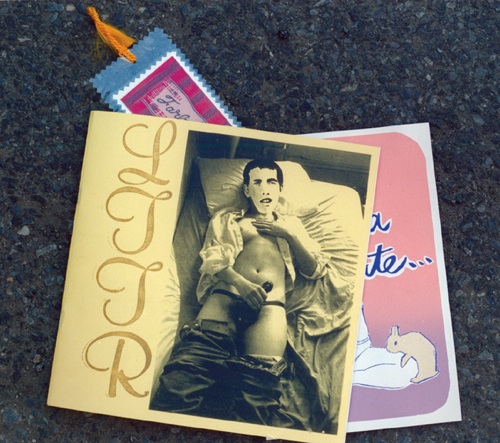
LTTR No.1 – Lesbians to the Rescue. Cover image: Emily Roysdon, “Untitled (David Wojnarowicz project),” 2002. 9 x 8.5 in. 32 pages. Edition of 1000 (300 with limited-edition artist multiples).
MP: What projects are you working on right now?
ER: I just wrote lyrics with The Knife for their upcoming album. I always try to have some collaborations happening alongside my self-initiated projects. I love collaborating with artists in their fields. Like, last year, I designed costumes for Vanessa Anspaugh, Faye Driscoll, and Levi Gonzalez.
MP: I loved Levi’s blue suit!
ER: Right now I’m working on a new piece that is going to be a very different process for me. Rehearsal has never been a part of my process, so for this new project I want to engage in it and with people who are trained in that practice. I’m interested in having more than one movement vocabulary, set of values, or ability. For instance, choreographers as well as performance artists. I’m interested in transitions and the idea of choreographic thinking across performance. I also have an idea for a photographic series that might happen simultaneously.
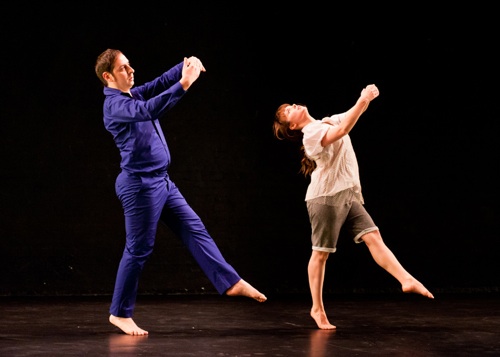
Emily Roysdon, “Counterfeit Scenario,” Feb 9-11, 2012 at The Kitchen. Choreographer: Levi Gonzalez. Performed by Levi Gonzalez (left) and Natalie Green (right). Photograph: Ian Douglas.




Pingback: Week in Review | Art21 Blog